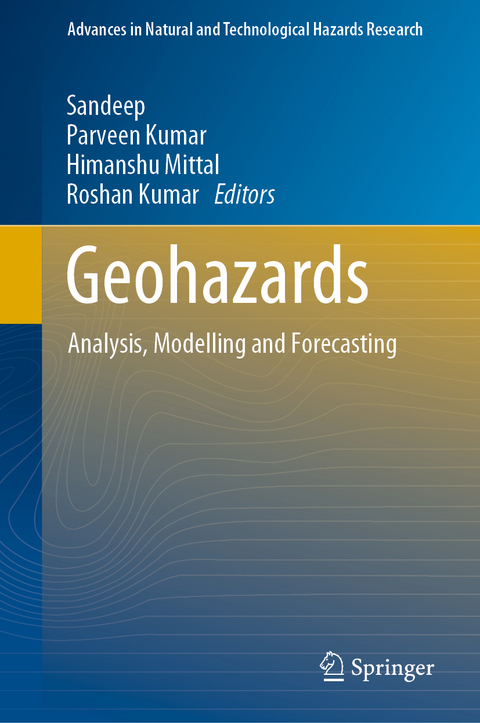
Geohazards
Springer Verlag, Singapore
978-981-99-3954-1 (ISBN)
Sandeep has been working as an assistant professor in the Department of Geophysics, Banaras Hindu University (BHU) since 2016. His research interests include simulating strong ground motions, Site estimations and Earthquake Early Warnings. He is a lead or co-author of 32 journal articles in international peer-reviewed journals. Sandeep has also contributed to the scientific community as a reviewer of many research articles and projects. Sandeep is a recipient of many prestigious awards including Order of Merit Award (Young Scientists) by Indian Society of Earthquake Science (ISES), J.G. Negi Young Scientist award by Indian Geophysical Union and SERB-SIRE fellowship by DST, GoI for his significant contributions in the field of seismology. Parveen Kumar currently works as a scientist at the Wadia Institute of Himalayan Geology, Dehradun, India. Earlier, he was awarded a post-doctoral fellow position sponsored by the University Grants Commission, India. He collaborated internationally in research with the Leibniz Institute for Applied Geophysics, Hanover, Germany. During his career, he has worked and is still working, on several sponsored and consultancy projects. His research interests include strong motion seismology, earthquake hazard evaluation, geohazard assessment such as landslide and avalanche hazards, and earthquake source studies. He has published over 37 research papers in SCI-indexed journals and supervised several Ph.D. and Master’s degree students. Himanshu Mittal currently works as a scientist-E at the National Centre for Seismology, under the Ministry of Earth Sciences, New Delhi, India. His major expertise is in strong-motion seismology, earthquake hazard assessment, site characterization and Earthquake Early Warning (EEW), among other areas. Earlier, he has worked at many positions including Research Associate and Scientist at IIT Roorkee, Research Scientist (Post-doc) atNational Taiwan University (NTU) and National Cheng Kung University (NCKU), Taiwan. Recently, he has developed EEW systems for different regions worldwide. He has published more than 40 research papers in SCI-indexed international journals and is actively engaged in collaboration with various national and international institutes. Roshan Kumar currently works as an assistant professor at the Department of Electronic and Information Technology, Miami College of Henan University, China. Earlier, he completed his post-doc position at Zhejiang University, China. His research interests include earthquake early warning systems, seismic signal processing and landslide warning systems. He holds a Ph.D. from the Indian Institute of Technology, Roorkee, India, and a Master’s from Thapar University, India. To date, he has published more than 15 papers in his short academic career.
1. Role of active tectonics in the estimation of seismic hazard of an area: A case study of western India
Kapil Mohan, Naveen Kumar, Rakesh Dumka and Sumer Chopra
2. Stress Scenario In The North-West Himalaya: What We Learnt From Post-Seismic Stress Changes
Somak Hajra and Devajit Hazarika
3. The crust and upper mantle structure beneath the Bangladesh and its effects on seismic hazard
Ritima Das, Utpal Saikia Gokul Kumar Saha
4. Seismological data quality controls - a synthesis
Cédric P. Legendre & Utpal Kumar
5. Use of Geophysical techniques in Seismic Hazard Assessment and Microzonation
Sumer Chopra, Pallabee Choudhury, Rakesh Nikam, Peush Chaudhary, Harsh Limbachiya and Vishwa Joshi
6. Earthquake response and its implications towards the structural design codes for Himalayan and adjoining regions of India
Babita Sharma and Manisha Sandhu
7. Liquefaction Potential Index (LPI): A Parameter to Assess Liquefaction Hazard
Supratim Chanda, Neeraj Kumar, D. Kushwaha
8. Earthquake Precursory Studies Using Radon Time Series Data in Taiwan: An Overview
Vivek Walia, Arvind Kumar, Ching-Chou Fu
9. Spatial prediction of earthquake-induced landslide susceptible zones - A case study from Indian Himalaya
Sandeep Kumar, Parveen Kumar, Sameeksha Kaushik, Yaspal Sundriyal, Vikram Gupta
10. Tsunamis in the past and recent years over Indian coasts: A review
Babita Dani, Vaibhava Srivastava, A. P. Singh, R. Bhatla
11. Instrumentation of India's First Regional Earthquake Early Warning System and Site Characterization of its Stations
Pankaj Kumar, Kamal, M.L. Sharma, R.S. Jakka, Pratibha
12. Overview of Artificial Intelligence (AI) and Machine Learning (ML) in Seismology
Harendra Kumar Dadhich
| Erscheinungsdatum | 01.09.2023 |
|---|---|
| Reihe/Serie | Advances in Natural and Technological Hazards Research |
| Zusatzinfo | 62 Illustrations, color; 5 Illustrations, black and white; XIV, 193 p. 67 illus., 62 illus. in color. |
| Verlagsort | Singapore |
| Sprache | englisch |
| Maße | 155 x 235 mm |
| Themenwelt | Naturwissenschaften ► Biologie ► Ökologie / Naturschutz |
| Naturwissenschaften ► Geowissenschaften ► Geologie | |
| Naturwissenschaften ► Geowissenschaften ► Geophysik | |
| Schlagworte | Artificial Intelligence • Disaster and Risk Mitigation • disaster risk reduction • Policy-relevant Knowledge • Vulnerability and Disaster |
| ISBN-10 | 981-99-3954-2 / 9819939542 |
| ISBN-13 | 978-981-99-3954-1 / 9789819939541 |
| Zustand | Neuware |
| Haben Sie eine Frage zum Produkt? |
aus dem Bereich


